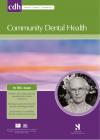Community Dental Health

- Cover Date:
- December 2011
- Print ISSN:
- 0265 539X
- Vol:
- 28
- Issue:
- 4
Association of pulp stones with coronary artery stenosis
Background: Dental pulp stones are discrete calcifications in the pulp chamber which are often seen in deciduous and permanent teeth. It has been hypothesised that atherosclerosis can be associated with their development. Objective: To determine whether a higher prevalence of dental pulp stones is correlated with coronary artery stenosis. Clinical setting: Sixty-one patients aged 20-55 years referred to Afshar Heart Center for invasive coronary angiography were invited to undergo panoramic dental radiography. The panoramic radiographs were independently examined for the presence of pulp stones. Results: Pulp stones were present in 82% (31/38) of patients with at least one clinically significant coronary artery stenosis and in 48% (11/23) of patients with normal coronary angiography. They were present in 13% of the teeth in the former group and in 5% of the teeth in the latter. The findings show a statistically significant association between coronary artery stenosis and presence of pulp stones (odds ratio 4.83, 95% confidence interval 1.5-15.4). Conclusion: Coronary artery stenosis and dental pulp calcification are significantly associated. Dental radiography has the potential to be used as a rapid screening method for the early detection of coronary artery stenosis.
Key words: dental pulp calcification, coronary stenosis, panoramic radiography
- Article Price
- £15.00
- Institution Article Price
- £
- Page Start
- 305
- Page End
- 307
- Authors
- F. Ezoddini-Ardakani, S.M. Namayandeh, S.M. Sadr-Bafghi, F. Fatehi, Z. Mohammadi, S. Shahrabi-Farahani, A.S. Hedayati, M.J. Rahmani-Baghemalek
Articles from this issue
- Title
- Pg. Start
- Pg. End
- Why has oral health promotion and prevention failed children requiring general anaesthesia for dental extractions?
- 255
- 258
- Predictors of utilisation of dental care services in a nationally representative sample of adults
- 269
- 273
- Applicability of both dentist and patient perceptions of dentists’ explanations to the evaluation of dentist–patient communication
- 274
- 279
- Evaluation of a preventive program based on caries risk among mentally challenged children using the Cariogram model
- 286
- 291
- The effect of a modified fluoride toothpaste technique on buccal enamel caries in adults with high caries prevalence: a 2-year clinical trial
- 292
- 296
- Association of clinical oral health status with self-rated oral health and GOHAI in Japanese adults
- 297
- 300
- Prevalence of periodontopathogens in a black Brazilian secluded community matched with a black urban population
- 301
- 304
- Incisor trauma in a Turkish preschool population: Prevalence and socio-economic risk factors
- 308
- 312
- Malocclusion and orthodontic treatment need measured by the Dental Aesthetic Index and its association with dental caries in Indian schoolchildren
- 313
- 316
